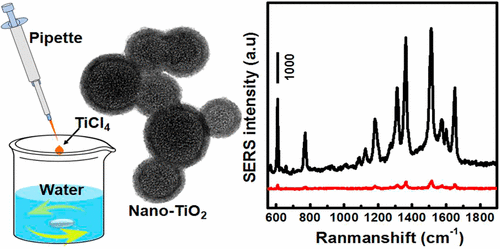Nanoscaled Amorphous TiO2 Hollow Spheres: TiCl4 Liquid Droplet-Based Hydrolysis Fabrication and Strong Hollow Structure-Enhanced Surface-Enhanced Raman Scattering Effects
作者:Haoming Bao, Hongwen Zhang, Guangqiang Liu, Yue Li, and Weiping Cai
期刊:Langmuir
卷(期)页:2017, 33 (22), pp 5430–5438
全文链接:http://pubs.acs.org/doi/abs/10.1021/acs.langmuir.7b00298

期刊:Langmuir
卷(期)页:2017, 33 (22), pp 5430–5438
全文链接:http://pubs.acs.org/doi/abs/10.1021/acs.langmuir.7b00298

A very simple route is developed for fast fabrication of nanosized amorphous titanium dioxide (TiO2) hollow spheres (THPs) just via dropping the pure four titanium chloride (TiCl4) liquid droplets into deionized water at around room temperature. The THPs, at around 80 nm in mean diameter, can be formed within a few seconds after dropping TiCl4 droplets into water. The shell layers of the obtained THPs are amorphous and porous in structure with a porosity of 58–80% and show a linear increase in thickness with the size of THPs. Further experiments have revealed that the reaction temperature, initial pH value, and size of the TiCl4 droplet are crucial to the formation, size, productivity, and microstructure of the THPs. A model is proposed on the basis of the fragmentation of liquid droplets, hydrolysis-induced formation, and inward growth of TiO2shell layers, which can well describe the formation of the THPs. Importantly, such amorphous nanoscaled THPs have exhibited some strong hollow structure-enhanced performances. Typically, the THP-built film shows the highest reflectivity in the visible region compared to the other structured TiO2 films. Especially, if it supports the film of the Au nanoparticle, the surface-enhanced Raman scattering effect is significantly enhanced by more than 1 order of magnitude. This work provides not only a simple and quick fabrication method for the THPs but also a new member for their family.
上一条:One-Step and Surfactant-Free Fabrication of Gold-Nanoparticle-Decorated Bismuth Oxychloride Nanosheets Based on Laser Ablation in Solution and Their Enhanced Visible-Light Plasmonic Photocatalysis
下一条:Periodic one-dimensional nanostructured arrays based on colloidal templates,applications,anddevices
下一条:Periodic one-dimensional nanostructured arrays based on colloidal templates,applications,anddevices
